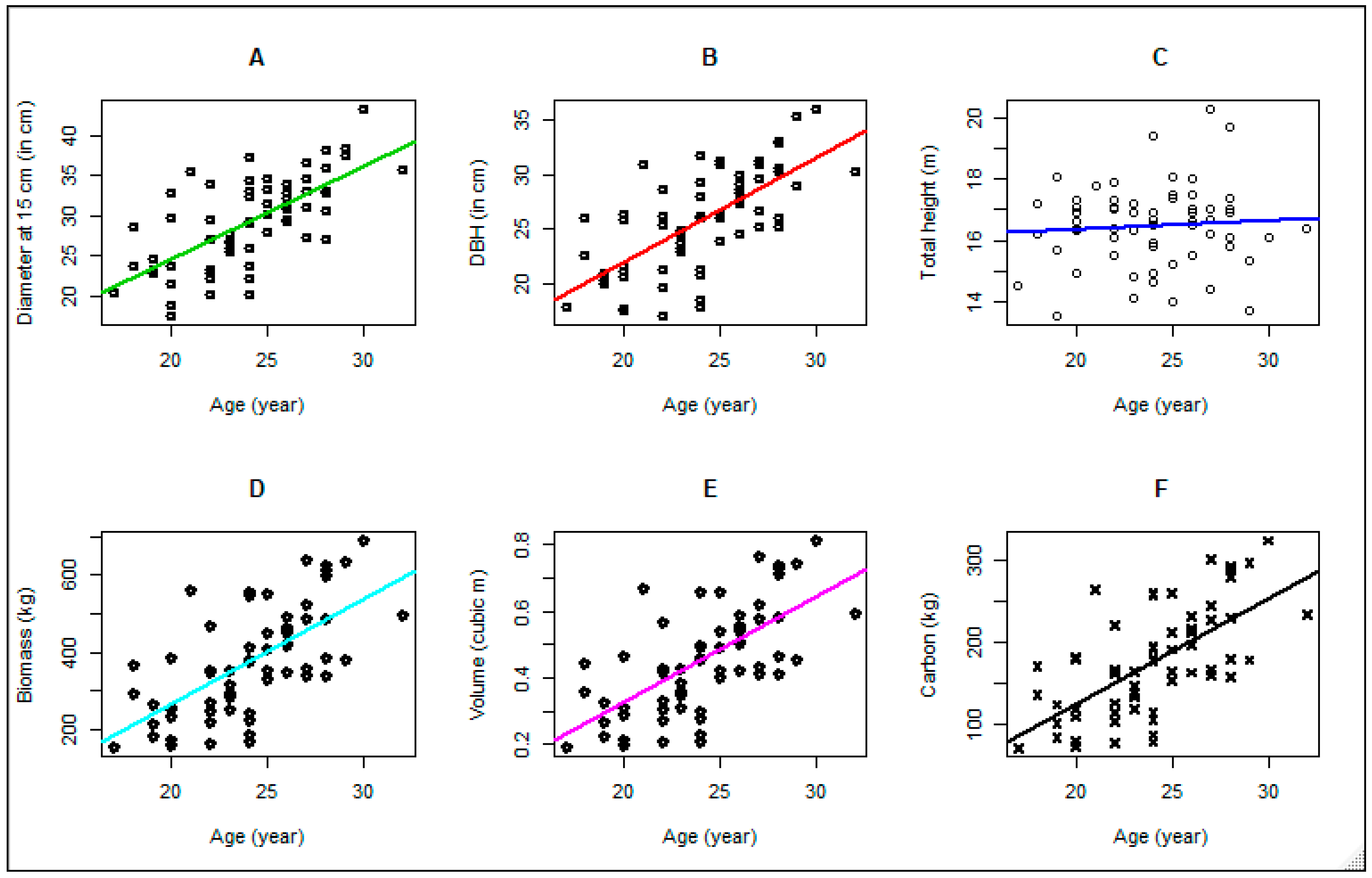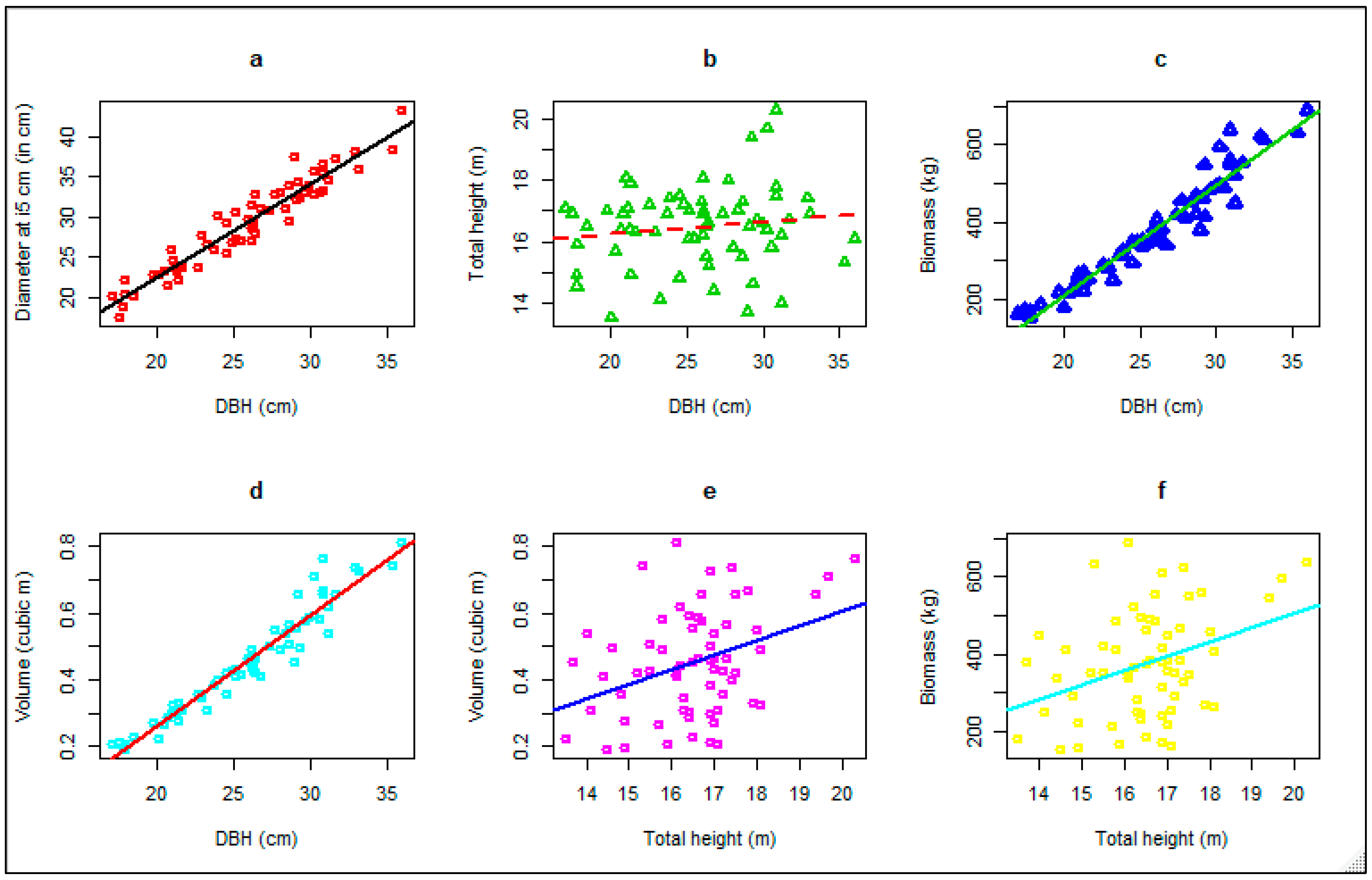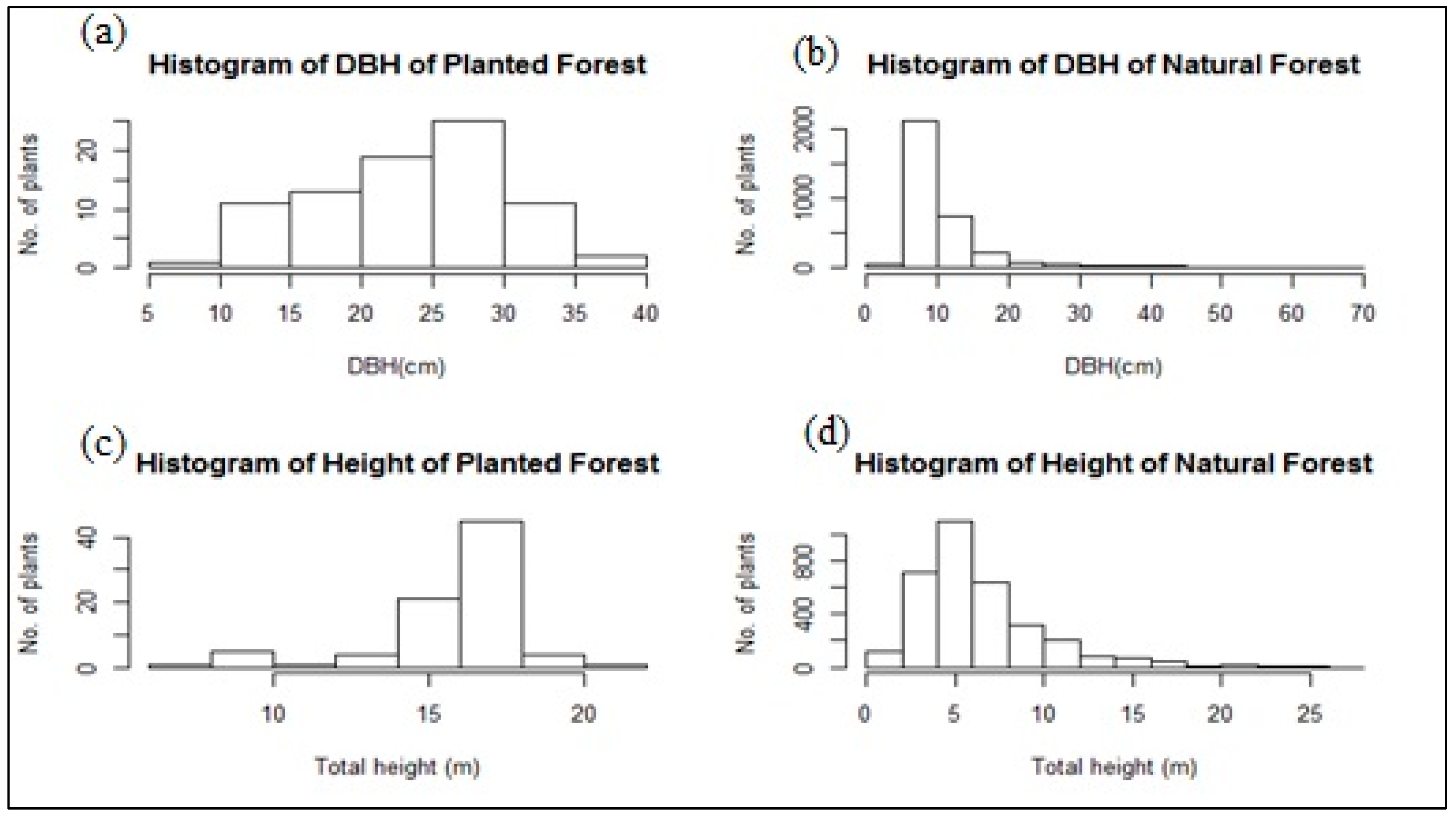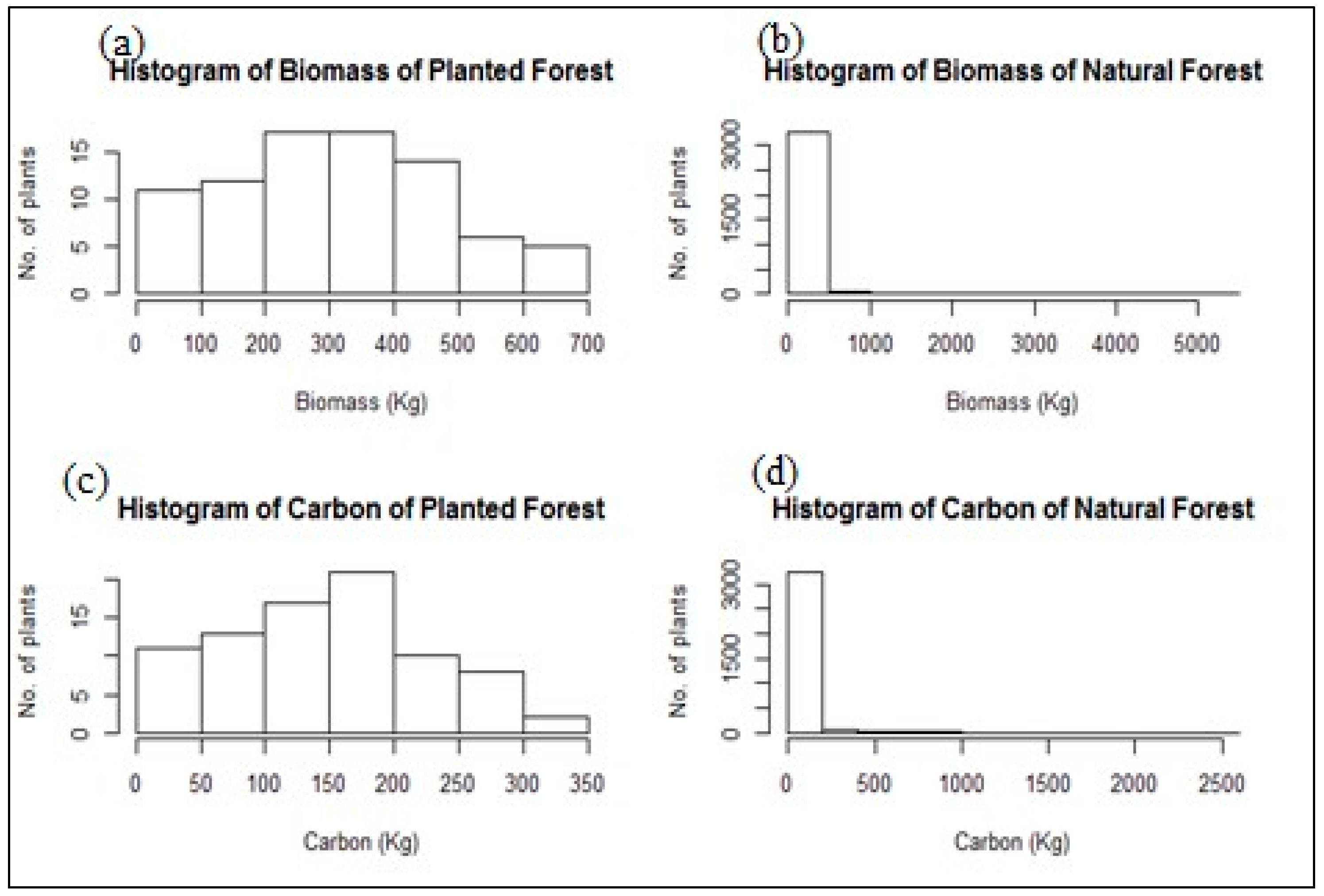Comparison of Planted Pine versus Natural Mix Forests in Nepal
Abstract
1. Introduction
2. Materials and Methods
2.1. Study Area
2.2. Sample Design and Data Collection
2.3. Biomass Estimation
2.4. Data Analysis
3. Results
3.1. Statistics of the Forests under Study
3.2. Stand Structure of the Forests
3.3. Comparison Based on Predicted Biomass
4. Discussion
4.1. Planted Pine Forest and Its Sustainability Perspective
4.2. Natural Mixed Forest and Its Sustainability Perspective
5. Conclusions
Author Contributions
Funding
Data Availability Statement
Acknowledgments
Conflicts of Interest
Appendix A
Appendix A.1. Data Collection Sheet Used in the Study
- Forest analysis form no.: .......
- Analyzer: .........................................
- Plot: ....................... m asl: .................... Date: ...................... GPS: .......... ........... ......... & ..... ..... .... Aspect: .............. Slope: .......... degree sign of wildlife: ........
- % Trees: ........... Bushes: ........ herbs/ferns: ......... grass: .......... moss: ...............
- % Exposed soil: .....................Litter: ............ Rock: .....................
- Disturbance (0–3): Lopped: ........ Cut: ...................... Droppings: ..............
| Local/Nepali name | Tree species (Latin name) | Basal Girth (at 15 cm) | Girth at Breast ht. (1.30 m) | H (height in m) | cut | 1 | 2 | 3 | 4 |
| Bushes species | |||||||||
| Climber species | |||||||||
| Local name | Latin name | Sub-plot 1 | Sub-plot 2 | Sub-plot 3 | Sub-plot 4 | ||||
| seedling | sapling | seedling | sapling | seedling | sapling | seedling | sapling | ||
Appendix A.2. Stand Structure of Pine Trees Selected for Coring

| Variables | Mean Value | p-Value | Significance |
|---|---|---|---|
| DBH (cm) | 25.78 | <2.2 × 10−16 | Yes |
| Height (m) | 16.48 | <2.2 × 10−16 | Yes |
| Mean age (year) | 23.97 | <2.2 × 10−16 | Yes |
| Biomass density estimated (kg/tree) | 375.39 | 0.00027 | Yes |
| Basal girth at 30 cm height (cm) | 91.82 | 0.00027 | Yes |
| Girth at breast height (cm) | 80.99 | <2.2 × 10−16 | Yes |
| Carbon density conversion (t/ha) | 176.43 | 0.00027 | Yes |
Appendix A.3. Correlation Test among Variables of Pine Forest
| Variables | Correlation Coefficient (r) | p-Value | Significance |
|---|---|---|---|
| Age vs. DBH | 0.68 | 1.2 × 10−9 | Yes |
| Age vs. Height | 0.08 | 0.534 | No |
| Age vs. Biomass | 0.65 | 7.58 × 10−9 | Yes |
| Age vs. Volume | 0.65 | 8.42 × 10−9 | Yes |
| DBH vs. Volume | 0.97 | 2.2 × 10−16 | Yes |
| Height vs. Volume | 0.36 | 0.003318 | Yes |
| DBH vs. Height | 0.14 | 0.279 | No |
| DBH vs. Biomass | 0.97 | 2.2 × 10−16 | Yes |
| Height vs. Biomass | 0.36 | 0.0042 | Yes |
| Basal girth vs. GBH | 0.96 | 2.2 × 10−16 | Yes |
Appendix A.4. Visual Relationship between the Variables of the Pine Forest in the Study Area


References
- Ritchie, H.; Roser, M. Forest Area. Our World Data 2024. Available online: https://ourworldindata.org/forest-area (accessed on 10 May 2024).
- Maraseni, T.N.; Neupane, P.R.; Lopez-Casero, F.; Cadman, T. An Assessment of the Impacts of the REDD+ Pilot Project on Community Forests User Groups (CFUGs) and Their Community Forests in Nepal. J. Environ. Manag. 2014, 136, 37–46. [Google Scholar] [CrossRef] [PubMed]
- Pant, D.; Shah, K.K.; Sharma, S.; Bhatta, M.; Tripathi, S.; Pandey, H.P.; Tiwari, H.; Shrestha, J.; Bhat, A.K. Soil and Ocean Carbon Sequestration, Carbon Capture, Utilization, and Storage as Negative Emission Strategies for Global Climate Change. J. Soil Sci. Plant Nutr. 2023, 23, 1421–1437. [Google Scholar] [CrossRef]
- MEA. Ecosystems and Human Well-Being: Synthesis; Millennium Ecosystem Assessment (Program); Island Press: Washington, DC, USA, 2005; ISBN 978-1-59726-040-4. [Google Scholar]
- Bai, J.; Wang, H.; Hu, Y. Prediction of Potential Suitable Distribution of Liriodendron Chinense (Hemsl.) Sarg. in China Based on Future Climate Change Using the Optimized MaxEnt Model. Forests 2024, 15, 988. [Google Scholar] [CrossRef]
- Pandey, H.P.; Aryal, K.; Aryal, S.; Maraseni, T.N. Understanding Local Ecosystem Dynamics in Three Provinces of the Lowlands of Nepal. Sci. Total Environ. 2023, 867, 161501. [Google Scholar] [CrossRef] [PubMed]
- Zhang, Y.; Yuan, C.; Hu, D.; Zhang, Y.; Hou, L.; Li, J.; Han, S.; Dou, Y.; Cao, J. Elevation Shapes Soil Microbial Diversity and Carbon Cycling in Platycladus Orientalis Plantations. Forests 2024, 15, 979. [Google Scholar] [CrossRef]
- FAO. The State of the World’s Forests 2022: Forest Pathways for Green Recovery and Building Inclusive, Resilient and Sustainable Economies. In The State of the World’s Forests (SOFO); FAO: Rome, Italy, 2022; ISBN 978-92-5-135984-6. [Google Scholar]
- Payn, T.; Carnus, J.-M.; Freer-Smith, P.; Kimberley, M.; Kollert, W.; Liu, S.; Orazio, C.; Rodriguez, L.; Silva, L.N.; Wingfield, M.J. Changes in Planted Forests and Future Global Implications. For. Ecol. Manag. 2015, 352, 57–67. [Google Scholar] [CrossRef]
- Vogt, P.; Riitters, K.; Caudullo, G.; Eckhardt, B. FAO—State of the World’s Forests: Forest Fragmentation; Publications Office of the European Union: Gare, Luxembourg, 2020. [Google Scholar]
- Amatya, S.M.; Shrestha, K.R.; Cedamon, E. Nepal Forestry Handbook; Nepal Foresters’ Association: Kathmandu, Nepal, 2016. [Google Scholar]
- DFRS Middle Mountains Forests of Nepal. Forest Resource Assessment (FRA) Nepal; Department of Forest Research and Survey (DFRS): Kathmandu, Nepal, 2015. [Google Scholar]
- Dangal, S.; Das, A. Effect of Management Practice and Age on Increment in Pinus Patula Plantations in Nepal. Banko Janakari 2018, 25, 30–38. [Google Scholar] [CrossRef][Green Version]
- Kanel, R. Twenty-Five Years of Community Forestry: Contribution to Millennium Development Goals. In Twenty-Five Years of Community Forestry: Fourth National Workshop on Community Forestry; Kanel, R.K., Mathema, P., Kandel, B.R., Niraula, D.R., Sharma, A.R., Gautam, M., Eds.; Department of Forests: Kathmandu, Nepal, 2004; pp. 118–123. [Google Scholar]
- Jackson, J.K. Manual of Afforestation in Nepal: Volume 2, 2nd ed.; Department of Forest Research and Survey: Kathmandu, Nepal, 1994; Volume 2. [Google Scholar]
- MOFSC. National Biodiversity and Action Plan of Nepal: 2014–2020; MOFSC: Mandurah, Australia, 2014. [Google Scholar]
- DFRS. State of Nepal’s Forests; Department of Forest Research and Survey: Kathmandu, Nepal, 2015; ISBN 978-9937-8896-3-6. [Google Scholar]
- Aase, T.H. Are Doomsday Scenarios Best Seen as Failed Predictions or Political Detonators? The Case of the ‘Theory of Himalayan Environmental Degradation. Geogr. J. Nepal 2017, 10, 1–14. [Google Scholar] [CrossRef]
- MOFSC. Resin Tapping Guidelines of Nepal; MOFSC: Mandurah, Australia, 2008. [Google Scholar]
- Brown, S.L.; Schroeder, P.; Kern, J.S. Spatial Distribution of Biomass in Forests of the Eastern USA. For. Ecol. Manag. 1999, 123, 81–90. [Google Scholar] [CrossRef]
- Gyawali, A.; Sharma, R.P.; Bhandari, S.K. Individual Tree Basal Area Growth Models for Chir Pine (Pinus Roxberghii Sarg.) in Western Nepal. J. For. Sci. 2015, 61, 535–543. [Google Scholar] [CrossRef]
- Khan, M.S.; Khan, S.; Shah, W.; Hussain, M.; Shah, M. Height Growth, Diameter Increment and Age Relationshipresponse Tosustainable Volumeof Subtropical Chir Pine (Pinusroxburghii)Forest of KarakerBarikot Forest. Pure Appl. Biol. 2016, 5, 560–567. [Google Scholar] [CrossRef]
- Aryal, P.C.; Dhamala, M.K.; Gaire, N.P.; Bhatta, S.; Suwal, M.K.; Bhuju, D.R.; Chhetri, P.K. Tree-Ring Climate Response of Two Larix Species from the Central Nepal Himalaya. Trop. Ecol. 2020, 61, 215–225. [Google Scholar] [CrossRef]
- Speer, J.H.; Bräuning, A.; Zhang, Q.-B.; Pourtahmasi, K.; Gaire, N.P.; Dawadi, B.; Rana, P.; Dhakal, Y.R.; Acharya, R.H.; Adhikari, D.L.; et al. Pinus Roxburghii Stand Dynamics at a Heavily Impacted Site in Nepal: Research through an Educational Fieldweek. Dendrochronologia 2017, 41, 2–9. [Google Scholar] [CrossRef]
- Brancheriau, L.; Ghodrati, A.; Gallet, P.; Thaunay, P.; Lasaygues, P. Application of Ultrasonic Tomography to Characterize the Mechanical State of Standing Trees (Picea abies). J. Phys. Conf. Ser. 2012, 353, 012007. [Google Scholar] [CrossRef]
- Arciniegas, A.; Prieto, F.; Brancheriau, L.; Lasaygues, P. Literature Review of Acoustic and Ultrasonic Tomography in Standing Trees. Trees 2014, 28, 1559–1567. [Google Scholar] [CrossRef]
- Brown, P.M.; Bhattacharyya, A.; Shah, S.K. Potential for Developing Fire Histories in Chir Pine (Pinus roxburghii) Forests in the Himalayan Foothills. Tree-Ring Res. 2011, 67, 57–62. [Google Scholar] [CrossRef]
- Gao, S.; Wang, X.; Wiemann, M.C.; Brashaw, B.K.; Ross, R.J.; Wang, L. A Critical Analysis of Methods for Rapid and Nondestructivedetermination of Wood Density in Standing Trees. Ann. For. Sci. 2017, 74, 27. [Google Scholar] [CrossRef]
- Guller, B.; Isik, K.; Cetinay, S.; Variations in the Radial Growth and Wood Density Components in Relation to Cambial Age in 30-Year-Old Pinus Brutia Ten. at Two Test Sites | SpringerLink. Available online: https://link.springer.com/article/10.1007/s00468-011-0675-2 (accessed on 30 August 2020).
- Campbell, R.; McCarroll, D.; Robertson, I.; Loader, N.J.; Grudd, H.; Gunnarson, B. Blue Intensity in Pinus Sylvestris Tree Rings: A Manual for A New Palaeoclimate Proxy. Tree-Ring Res. 2011, 67, 127–134. [Google Scholar] [CrossRef]
- Paudyal, K.; Baral, H.; Burkhard, B.; Bhandari, S.P.; Keenan, R.J. Participatory Assessment and Mapping of Ecosystem Services in a Data-Poor Region: Case Study of Community-Managed Forests in Central Nepal. Ecosyst. Serv. 2015, 13, 81–92. [Google Scholar] [CrossRef]
- Gaire, N.P.; Bhuju, D.R.; Koirala, M. Dendrochronological Studies in Nepal: Current Status and Future Prospects. FUUAST J. Biol. 2013, 3, 1–9. [Google Scholar]
- Bontemps, J.-D.; Hervé, J.-C.; Dhôte, J.-F. Dominant Radial and Height Growth Reveal Comparable Historical Variations for Common Beech in North-Eastern France. For. Ecol. Manag. 2010, 259, 1455–1463. [Google Scholar] [CrossRef]
- Austin, J.M.; Mackey, B.G.; Van Niel, K.P. Estimating Forest Biomass Using Satellite Radar: An Exploratory Study in a Temperate Australian Eucalyptus Forest. For. Ecol. Manag. 2003, 176, 575–583. [Google Scholar] [CrossRef]
- Baishya, R.; Barik, S.; Upadhaya, K. Distribution Pattern of Aboveground Biomass in Natural and Plantation Forests of Humid Tropics in Northeast India. Trop. Ecol. 2009, 50, 295–304. [Google Scholar]
- Yang, J.; Cooper, D.J.; Li, Z.; Song, W.; Zhang, Y.; Zhao, B.; Han, S.; Wang, X. Differences in Tree and Shrub Growth Responses to Climate Change in a Boreal Forest in China. Dendrochronologia 2020, 63, 125744. [Google Scholar] [CrossRef]
- Nasi, R.; Putz, F.E.; Pacheco, P.; Wunder, S.; Anta, S. Sustainable Forest Management and Carbon in Tropical Latin America: The Case for REDD+. Forests 2011, 2, 200–217. [Google Scholar] [CrossRef]
- Pandey, H.P.; Pokhrel, S. Stocking Density and DBH Distribution of Community Forests in Nepal. Small-Scale For. 2021, 20, 145–159. [Google Scholar] [CrossRef]
- Subedi, C.K.; Gurung, J.; Ghimire, S.K.; Chettri, N.; Pasakhala, B.; Bhandari, P.; Chaudhary, R.P. Variation in Structure and Composition of Two Pine Forests in Kailash Sacred Landscape, Nepal. Banko 2018, 28, 26–36. [Google Scholar] [CrossRef]
- DOS. Survey Department: Geographical Location of the Districts. Available online: http://dos.gov.np/? (accessed on 31 August 2020).
- DHM. Department of Hydrology and Meteorology. Available online: http://dhm.gov.np/meteorological-station/ (accessed on 27 June 2020).
- ANSAB. Guidelines for Measuring Carbon Stocks in Community-Managed Forests; ANSAB: Kathmandu, Nepal, 2011. [Google Scholar]
- Chave, J.; Andalo, C.; Brown, S.; Cairns, M.; Chambers, J.; Eamus, D. Tree Allometry and Improved Estimation of Carbon Stock. Oecologia 2005, 145, 87–99. [Google Scholar] [CrossRef]
- Pandey, H.P.; Bhandari, S.K.; Harrison, S. Comparison among Allometric Models for Tree Biomass Estimation Using Non-Destructive Trees’ Data. Trop. Ecol. 2022, 63, 263–272. [Google Scholar] [CrossRef]
- REDD. Cell the Forest Carbon Measurement Guidelines; REDD: Kathmandu, Nepal, 2011. [Google Scholar]
- IPCC. 2019 Refinement to the 2006 IPCC Guidelines for National Greenhouse Gas Inventories; IPCC: Kathmandu, Nepal, 2019. [Google Scholar]
- MacDicken, K. A Guide to Monitoring Carbon Storage in Forestry and Agroforestry Projects; Winrock International Institute for Agricultural Development Arlington: Arlington, Virginia, 1997. [Google Scholar]
- de Winter, J.C.F. Using the Student’s t-Test with Extremely Small Sample Sizes. Pract. Assess. Res. Eval. 2019, 18, 10. [Google Scholar] [CrossRef]
- Pandey, H.P.; Pokhrel, N.P. Tapering, Tree Rings and Biomass Production of Pinus Roxburghii (Sarg.): A Dendrochronological Study; MDPI: Basel, Switzerland, 2020. [Google Scholar]
- McTague, J.P.; Weiskittel, A. Evolution, History, and Use of Stem Taper Equations: A Review of Their Development, Application, and Implementation. Can. J. For. Res. 2021, 51, 210–235. [Google Scholar] [CrossRef]
- Pham, H. A New Criterion for Model Selection. Mathematics 2019, 7, 1215. [Google Scholar] [CrossRef]
- Jurečková, J.; Picek, J. Shapiro–Wilk-Type Test of Normality under Nuisance Regression and Scale. Comput. Stat. Data Anal. 2007, 51, 5184–5191. [Google Scholar] [CrossRef]
- Crow, T.R.; Schlaegel, B.E. A Guide to Using Regression Equations for Estimating Tree Biomass. North. J. Appl. For. 1988, 5, 15–22. [Google Scholar] [CrossRef]
- R Core Team. R: A Language and Environment for Statistical Computing. R Foundation for Statistical Computing, Vienna, Austria. R Version 4.3.1. 2023. Available online: https://www.r-project.org/ (accessed on 30 August 2020).
- Põldveer, E.; Korjus, H.; Kiviste, A.; Kangur, A.; Paluots, T.; Laarmann, D. Assessment of Spatial Stand Structure of Hemiboreal Conifer Dominated Forests According to Different Levels of Naturalness. Ecol. Indic. 2020, 110, 105944. [Google Scholar] [CrossRef]
- Bontemps, J.D.; Herve, J.C.; Dhote, J.F. Long-Term Changes in Forest Productivity: A Consistent Assessment in Even-Aged Stands. For. Sci. 2009, 55, 549–564. [Google Scholar] [CrossRef]
- Kidd, K.R.; Copenheaver, C.A.; Zink-Sharp, A. Frequency and Factors of Earlywood Frost Ring Formation in Jack Pine (Pinus Banksiana) across Northern Lower Michigan. Écoscience 2014, 21, 157–167. [Google Scholar] [CrossRef]
- Kongsager, R. Speed Bump or Accelerator. In Proceedings of the NEEDS 2019: The Fourth Northern European Conference on Emergency and Disaster Studies, Uppsala, Sweden, 10–12 June 2019; pp. 31–32. [Google Scholar]
- Miles, L.; Kapos, V. Reducing Greenhouse Gas Emissions from Deforestation and Forest Degradation: Global Land-Use Implications. Science 2008, 320, 1454–1455. [Google Scholar] [CrossRef] [PubMed]
- Lal, M.; Singh, R. Carbon Sequestration Potential of Indian Forests. Environ Monit Assess 2000, 60, 315–327. [Google Scholar] [CrossRef]
- Bhandari, S.K.; Pinno, B.D.; Thomas, B.R. Tree Improvement Increases the Growth of White Spruce (Picea glauca): Evidence from 15-Year-Old Operational Plantations in Alberta. For. Ecol. Manag. 2024, 561, 121855. [Google Scholar] [CrossRef]



| Variables | Planted Pine Forest | Natural Mix Forest | Remarks |
|---|---|---|---|
| Tentative area of forest | 20 ha | 249 ha | Both forests lie in contagious landscape |
| Sample plot taken for measurement | 20 | 69 | 100 m2 in size for each plot |
| Zones | Sub-tropical | Sub-tropical | Same zone |
| management | Community managed | Community managed | Conventional protection-based |
| Topographic characteristics | East-south facing, gentle to moderate slope | East-south facing, gentle to moderate slope | Similar topographic features |
| Interventions | Traditional protection-based management and pruning | Traditional-protection based management | Communities manage forests as per the forest operational plan of community forests |
| Tree cover | Mostly dominant by trees, dense canopy | Mostly dominant by a pole-sized, sparse canopy | |
| Regeneration | Nil except for intermittent enrichment plantation | Natural regeneration | |
| Bushes | Nil except for some invasive species in some plots | Presence in almost all plots | |
| Exposed soil | Almost all plots | Almost nil | |
| Litter cover | Pine needles | Natural decomposing | |
| Sign of wildlife | Almost nil | Wildlife signs were in abundance | |
| Climber | Absent | Present | |
| Fern cover | Nil | occasional | |
| Lopping | Absent | Fodder collection | |
| Diversity | Monoculture (single species) | Diverse species composition (more than 26 species) |
| S.N. | Parameters | Planted Pine | Natural Mix Forest | Remarks |
|---|---|---|---|---|
| 1 | Mean age (years) | 24 | 16 | Natural forest’s age has been derived from Jackson, 1994 [15] (with interpolation of mean DBH and height) |
| 2 | Mean height (m) | 15.73 | 6.7 | |
| 3 | Mean DBH (cm) | 23.13 | 10.47 | |
| 4 | No. of plots | 20 | 69 | |
| 5 | No. of trees | 1582 | 3346 | |
| 6 | Mean wood density (kg/m3) | 0.65 | 0.83 | |
| 7 | Biomass (ton/ha) | 409.76 | 133.87 | Root-shoot ratio 1:5 |
| 8 | MAI (t/ha) | 17.07 | 8.37 | |
| 9 | Carbon Stock (C t/ha) | 189.77 | 62.82 | |
| 10 | Stock (number/ha) | 1080-trees 100-reg. | 1557-trees 35,217-reg. | Reg. = regenerations |
| 11 | Tentative area studied (ha) | 20 | 249 | |
| 12 | Undergrowth | Nil or nominal | Profound | Source: field survey |
| 13 | The presence of frequent fire | Present | Absent | Source: field survey |
| 14 | Natural regeneration | Absent | Present | Source: field survey |
| Variables | p-Value | SD-Planted Pine | SD-Natural Mixed Forest |
|---|---|---|---|
| Basal girth at 15 cm | <0.05 | 23.66 | 26.08 |
| Girth at breast height | <0.05 | 20.65 | 21.18 |
| DBH | <0.05 | 6.57 | 6.74 |
| Total height | <0.05 | 2.52 | 6.74 |
| Wood density | <0.05 | 0 | 0.08 |
| Biomass per tree | <0.05 | 170.24 | 246.83 |
| Carbon per tree | <0.05 | 80.01 | 116.01 |
| S.N. | When | Mean Age of Pinus | Pinus Biomass (t/ha) | The Mean Age of Natural Forest | Natural Mixed Forest Biomass (t/ha) |
|---|---|---|---|---|---|
| 1 | Ten years ago | 14 | 239.03 | 6 | 50.2 |
| 2 | Five years ago | 19 | 324.4 | 11 | 92.04 |
| 3 | Field survey | 24 | 409.76 | 16 | 133.87 |
| 4 | After five years | 29 | 495.13 | 21 | 175.7 |
| 5 | After 10 years | 34 | 580.49 | 26 | 217.54 |
| 6 | After 15 years | 39 | 665.86 | 31 | 259.37 |
Disclaimer/Publisher’s Note: The statements, opinions and data contained in all publications are solely those of the individual author(s) and contributor(s) and not of MDPI and/or the editor(s). MDPI and/or the editor(s) disclaim responsibility for any injury to people or property resulting from any ideas, methods, instructions or products referred to in the content. |
© 2024 by the authors. Licensee MDPI, Basel, Switzerland. This article is an open access article distributed under the terms and conditions of the Creative Commons Attribution (CC BY) license (https://creativecommons.org/licenses/by/4.0/).
Share and Cite
Pandey, H.P.; Maraseni, T.N.; Pokhrel, S. Comparison of Planted Pine versus Natural Mix Forests in Nepal. Forests 2024, 15, 1070. https://doi.org/10.3390/f15061070
Pandey HP, Maraseni TN, Pokhrel S. Comparison of Planted Pine versus Natural Mix Forests in Nepal. Forests. 2024; 15(6):1070. https://doi.org/10.3390/f15061070
Chicago/Turabian StylePandey, Hari Prasad, Tek Narayan Maraseni, and Shila Pokhrel. 2024. "Comparison of Planted Pine versus Natural Mix Forests in Nepal" Forests 15, no. 6: 1070. https://doi.org/10.3390/f15061070
APA StylePandey, H. P., Maraseni, T. N., & Pokhrel, S. (2024). Comparison of Planted Pine versus Natural Mix Forests in Nepal. Forests, 15(6), 1070. https://doi.org/10.3390/f15061070






